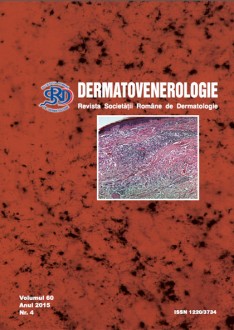Scopul studiului: Studiul efectuat urmareste evidentierea aspectelor epidemiologice, clinice, paraclinice si terapeutice in sclerodermie.
Material si metoda: Acest studiu este unul retrospectiv, bazat pe documentele medicale ale pacientilor cu sclerodermie internati in Clinica de Dermatovenerologie, desfasurat pe o perioada de 4 ani. Au fost inclusi in studiu un numar de 50 de pacienti. Datele obtinute au permis clasificarea bolnavilor in raport cu repartitia pe sexe, pe grupe de varsta, pe mediu de provenienta, aspecte clinice si paraclinice, tipul tratamentului instituit.
Rezultate: Prevalenta bolii pe durata celor 4 ani a fost de 0.68%. Sclerodermia a predominat in randul populatiei din mediul rural, mai frecvent la sexul feminin, cu un raport de 4:1. Varsta minima la care a fost diagnosticata sclerodermia a fost de 7 ani, iar cea maxima de 73 de ani, cu un varf de incidenta intre 40 – 70 ani (64%). 70% dintre cazuri au fost reprezentate de forma limitata a bolii, dintre care 28 cazuri de sclerodermie in placi, 5 cazuri de sclerodermie generalizata si 2 cazuri de sclerodermie in banda. Restul de 30% dintre cazuri au prezentat forma sistemica a bolii, dintre care 8 forma difuza, 4 forma cu acroscleroza si 3 sindrom Crest. Corticoterapia topica a fost utilizata in peste 90% dintre cazurile de sclerodermie limitata si la toti cei cu forma sistemica, la care s-au adaugat suplimente alimentare, imunosupresoare, corticoterapie sistemica in functie de particularitatea cazului.
Concluzii: Sclerodermia reprezinta o patologie dermatologica rara, dar complexa, variind de la forme usoare, pana la cele grave cu evolutie fulminanta care pun rapid in pericol viata pacientului.


